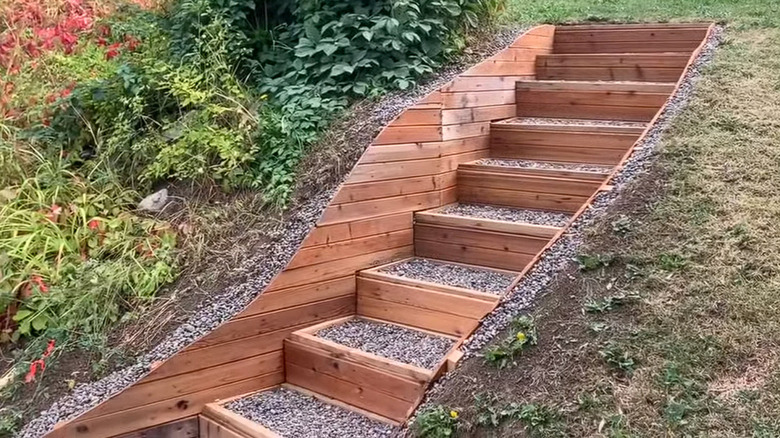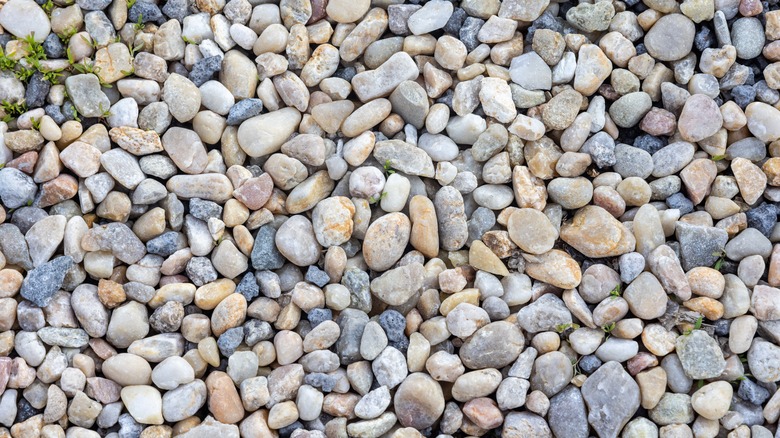TikTok's Built-In Outdoor Staircase DIY Is Raising Some Safety Concerns
So, you made some outdoor pea gravel steps. After reading an HGTV tutorial and seeing about 1.4 million examples on Google, you followed the instructions carefully and everything seems just fine. Except on TikTok, where home renovation DIYer @athomewithbae posted a couple of build videos, and people are concerned. Very concerned. "[T]hat wood is gonna rot fast!" warned on commenter about the ground contact-rated pressure-treated lumber. "Rocks are dangerous. Accident ready to happen," said another, concerned that the pea gravel will turn into ball bearings and send you comically back-pedaling into a nearby roadway. "That's gonna be a mess," another added to the chorus of disapproval. The overall message: the whole thing is going to wreak havoc before sinking into oblivion. What were they thinking?
The commenters on @athomewithbae's video appear to be concerned with both safety and eventual decay. Because of this, they seem to feel you must engineer any home improvement project to within an inch of madness. Anyway... the enclave of entropy enthusiasts is basically right: Everything will pass away. And, to be sure, there are important things to consider before installing a pea gravel patio or stairway. You can combat the breakdown and decay of your projects badly, you can combat it reasonably well, or you can build your steps to endure until the sun explodes. The middle option seems like a good option... and it is exactly what @athomewithbae and her husband, Sean, did.
There are some real concerns about pea gravel steps
A sound gravel stair installation requires understanding some of the ways that pea gravel steps break down over time, so let's have a look at what might — or, in fact, will — go wrong. There are three major problems, if by "major" you mean "relatively minor": pea gravel will get kicked and tracked away; the wood you're using to retain the gravel will rot by the time your grandchildren are old enough to replace them; and your stairs will almost certainly sink a little over time. Regarding the first concern, you can top off the pea gravel or encase it in cement or epoxy. Pea gravel is rounded and can, unlike other types of rock used in landscaping, get slippery with moss or mold, but installing it properly will reduce this risk. As for the lumber, since residential uses of chromated copper arsenate in treated lumber was only curtailed in 2004, no one is sure how long alternatives like alkaline copper quaternary will last. If you're concerned you can always spend a little more on plastic or composite wood substitutes.
The sinking feeling you get when looking at your pea gravel steps after a few months isn't in your imagination. A few factors can cause it to sink over time: gravel loss due to traffic, settling of the soil, and erosion from rain and sprinklers. Erosion can be exacerbated by the activity of burrowing animals like gophers, and ant colonies.
Building pea gravel steps for the future
The solution to these eventual concerns is to build the steps right in the first place... which is pretty much what @athomewithbae and Sean did. The key to minimizing your sinking step problem is in the foundation. Start by tamping down the soil with a tamper or lawn roller. Keep the tamper handy, because you'll need it again soon. Lay down a base layer of crushed rock or mason sand. Tamp that down and cover it with landscape cloth. On top of that, lay 2-3 inches of pea gravel and tamp well. This strategy will reduce both erosion and gravel travel. But, as we've acknowledged, nothing is permanent, so it's important to tamp and rake the steps periodically and top off the gravel every 3-4 years or so, as needed.
A few other tips for successful pea gravel steps: Make sure each step is level; your tamper is useful for this. Secure the timbers to the ground using 24-inch rebar, hammer through ½-inch holes in your wood. Seal the ends of your landscaping timber with an end-treatment sealant. You can also add pavers, though these will also sink over time and must be leveled periodically. And, finally, make sure you tell everyone on TikTok how to do it right or, at least, how they're doing it wrong.


